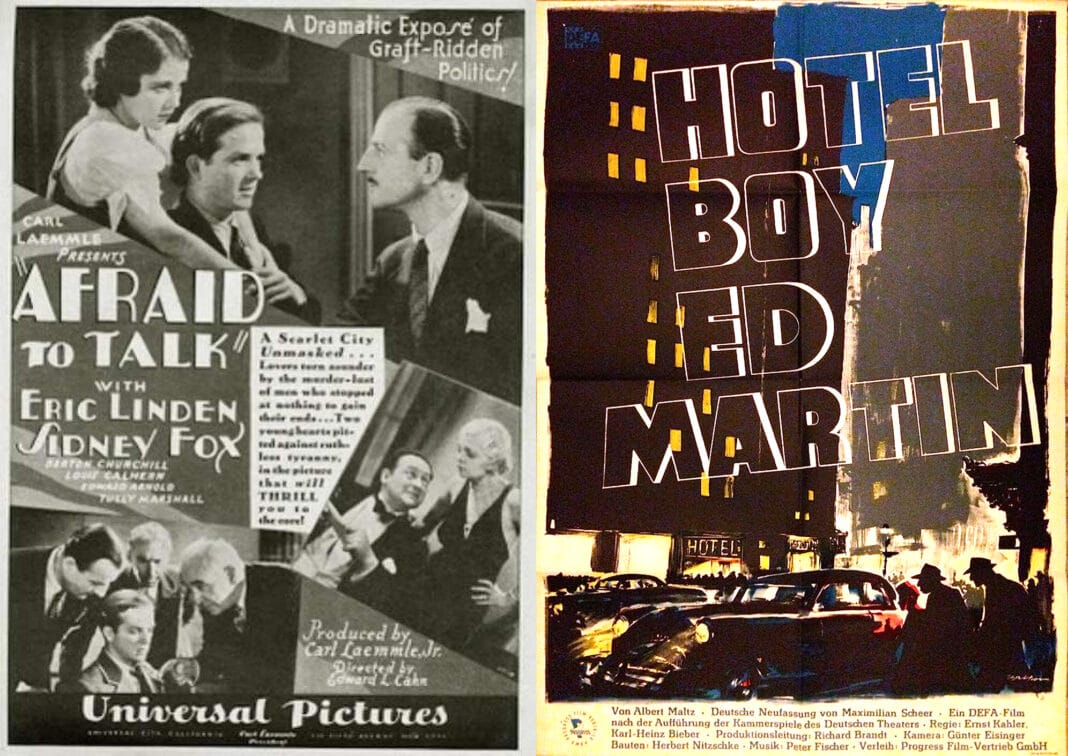Movie Review: Afraid to Talk vs. Hotelboy Ed Martin
In the world of cinema, adaptations often take on a life of their own, reshaping stories and characters to fit the medium. In this review, we delve into the contrasting interpretations of the play “Merry Go Round” in the films “Afraid to Talk” and “Hotelboy Ed Martin.” Each film offers a unique perspective on corruption, justice, and the human experience. Let’s explore the nuances of these cinematic adaptations and uncover the hidden gems within.
Full Review
Both “Afraid to Talk” and “Hotelboy Ed Martin” are based on the play “Merry Go Round” by Albert Maltz and George Sklar, shedding light on the dark underbelly of corruption in society. The narrative follows Ed Martin, a bellhop entangled in a web of deceit after witnessing a murder. While the original play paints a grim picture of a corrupt system, the film adaptations take divergent paths in their storytelling.
The 1932 film “Afraid to Talk,” directed by Edward L. Cahn, deviates from the play’s bleak ending, offering a glimmer of hope as Ed Martin escapes his tragic fate. Despite the change in outcome, the film retains its subversive edge, critiquing money-driven corruption with a poignant message. Cahn’s deft direction breathes life into the stage play, transforming it into a cinematic experience that resonates with audiences.
On the other hand, the 1955 film “Hotelboy Ed Martin,” co-directed by Ernst Kahler and Karl-Heinz Bieber, stays true to the play’s original staging in East Germany. While omitting the hanging scene, the film captures the essence of the play with cinematic touches that enhance the narrative. Ulrich Thein’s portrayal of Ed Martin adds depth to the character, bringing a sense of authenticity to the story.
Conclusion
In conclusion, both “Afraid to Talk” and “Hotelboy Ed Martin” offer compelling interpretations of the play “Merry Go Round,” each bringing a unique perspective to the narrative. While the 1932 film excels in its cinematic prowess and message against corruption, the 1955 film stays faithful to the original play’s spirit, capturing the essence of the story on screen. Both films stand as testaments to the enduring power of storytelling in cinema.
FAQs
1. What is the original play that inspired the films “Afraid to Talk” and “Hotelboy Ed Martin”?
The films are based on the play “Merry Go Round” by Albert Maltz and George Sklar, which delves into the theme of corruption in American society.
2. Who were the key directors and actors involved in the two film adaptations?
“Afraid to Talk” was directed by Edward L. Cahn and starred Eric Linden, while “Hotelboy Ed Martin” was co-directed by Ernst Kahler and Karl-Heinz Bieber, with Ulrich Thein in the lead role.
3. How do the endings of the two films differ from the original play?
The 1932 film “Afraid to Talk” offers a more optimistic ending, while the 1955 film “Hotelboy Ed Martin” stays closer to the play’s original conclusion.
4. What cinematic techniques were employed in each film to enhance the storytelling?
Both films utilized different approaches to bring the play to life on screen, with “Afraid to Talk” focusing on cinematic flair and “Hotelboy Ed Martin” capturing the essence of the stage production.
5. How did the political context of the time influence the reception of the original play?
The play “Merry Go Round” faced scrutiny due to its critique of corruption in American government, garnering attention from both the press and political officials.
6. What were the challenges faced by the directors and actors in bringing the play to the screen?
From casting decisions to adapting the play for a cinematic audience, the filmmakers navigated various obstacles to create compelling adaptations of “Merry Go Round.”
7. How did the films resonate with audiences at the time of their release?
Both films garnered attention for their thematic depth and engaging performances, sparking discussions about corruption and justice in society.
8. What legacy do these films leave in the realm of cinematic adaptations?
The contrasting approaches of “Afraid to Talk” and “Hotelboy Ed Martin” highlight the diverse ways in which stories can be interpreted and reimagined for the screen, showcasing the artistry of filmmaking.
9. How did the filmmakers balance artistic vision with commercial considerations in adapting the play?
While staying true to the core themes of the play, the filmmakers navigated the demands of the industry to create films that resonated with audiences and critics alike.
10. What insights can viewers gain from comparing the two film adaptations?
By exploring the differences and similarities between “Afraid to Talk” and “Hotelboy Ed Martin,” viewers can gain a deeper appreciation for the nuances of storytelling and the impact of cinematic interpretation on narrative themes.
Tags
#MovieReview #CinematicAdaptations #Corruption #Justice #MerryGoRound

